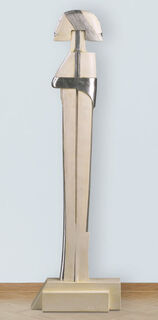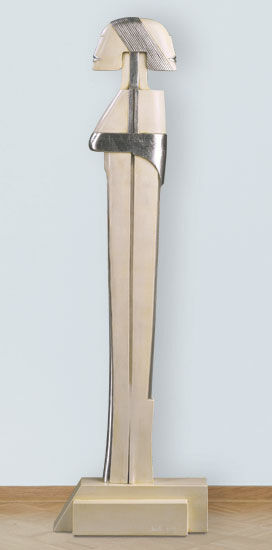Sculpture "Ambiguity", artificial marble version
Sculpture "Ambiguity", artificial marble version
Quick info
limited, 199 copies | numbered | signed | artificial marble | partly silver-plated | height 110 cm | weight approx. 15 kg
Detailed description
Sculpture "Ambiguity", artificial marble version
In many religions, the deity was imagined as a two-gendered being, and in Plato's "Symposium" Aristophanes tells the myth of the originally two-headed two-gendered human being. From the ancient Chinese ying-yang teachings and the experiments of the alchemists to modern depth psychology and biogenetics, the speculations about the separation and reunification of the male and female principle line up.
Günther Stimpfl has brought this elementary bipolarity, the duality of existence, the mental-bodily ambivalence and the fusion of two bodies to a strict, abstract formula with his idol thematising such interrelationships.
Statue "Ambiguity": Limited world edition total of 458 copies. Numbered and signed. Height 110 cm. Standing area 32 x 13 cm. Weight approx. 15 kg. Edition in white, polymer-bound artificial marble. Limited edition of 199 copies. Partially silver-plated.
About Günther Stimpfl
Günther Stimpfl's rise to the art elite began in Vienna. There he was a master student of Fritz Wotruba and Joannis Avramidis at the Academy of Fine Arts between 1964 and 1972. From 1972 to 1984, he attracted attention with designs for mobile wind and water objects. Since 1985, Günther Stimpfl has been working as a freelance sculptor.
His static-figurative large and small sculptures, which have attracted great attention in exhibitions in the art centres of Europe, are today highlights of important public and private collections.
Günther Stimpfl reflects the human need to express its spiritual world with visible symbols through sculptures that are modern and archaic. The weightless elegance of his impressive works of art – like the idols of lost cultures – stimulates the mind and imagination and fulfils the human longing for beauty that transcends time.
Marble powder is polymer-bonded. Artificial marble is characterised by a fine white surface that appears very similar to marble.
Term for an art object (sculpture, installation), which is produced in multiple copies in a limited and numbered edition according to the artist‘s will.
Artist's multiples have been called the most accessible and affordable art on the market.
A plastic work of sculptural art made of wood, stone, ivory, bronze or other metals.
While sculptures from wood, ivory or stone are made directly from the block of material, in bronze casting a working model is prepared at first. Usually, it is made of clay or other easily mouldable materials.
The prime time of sculpture after the Greek and Roman antiquity was the Renaissance. Impressionism gave a new impulse to the sculptural arts. Contemporary artists such as Jorg Immendorf, Andora, and Markus Lupertz also enriched sculptures with outstanding works.






